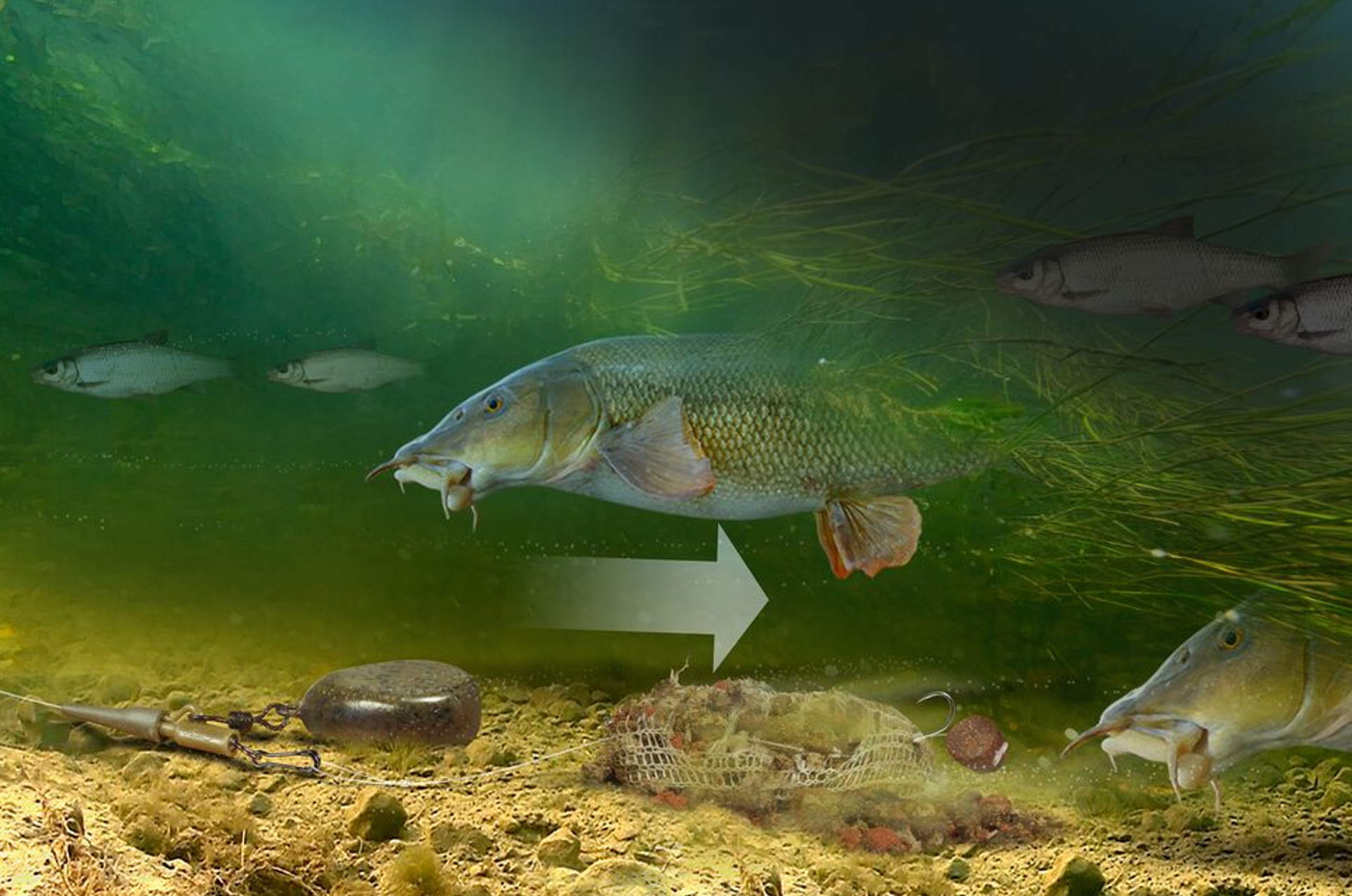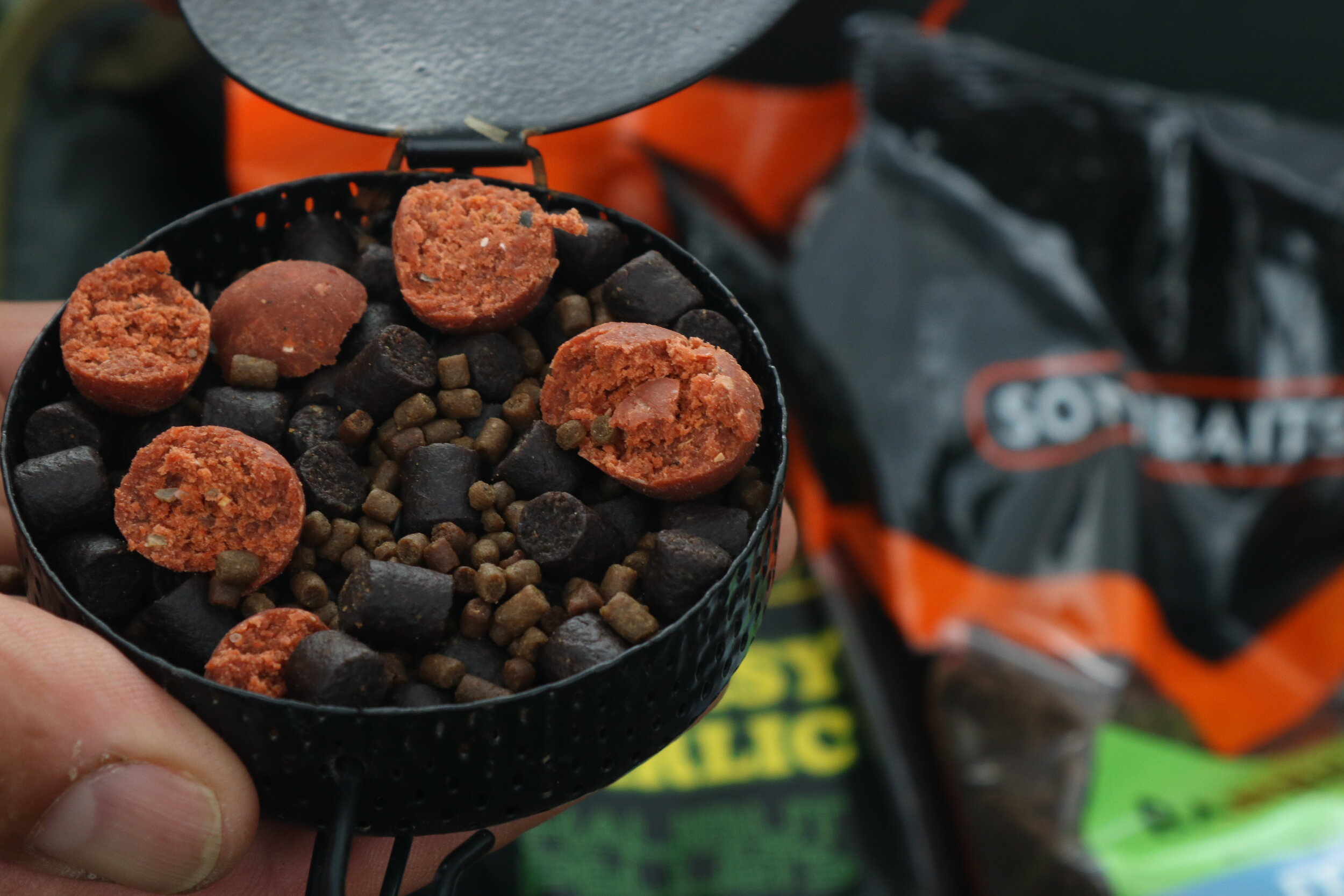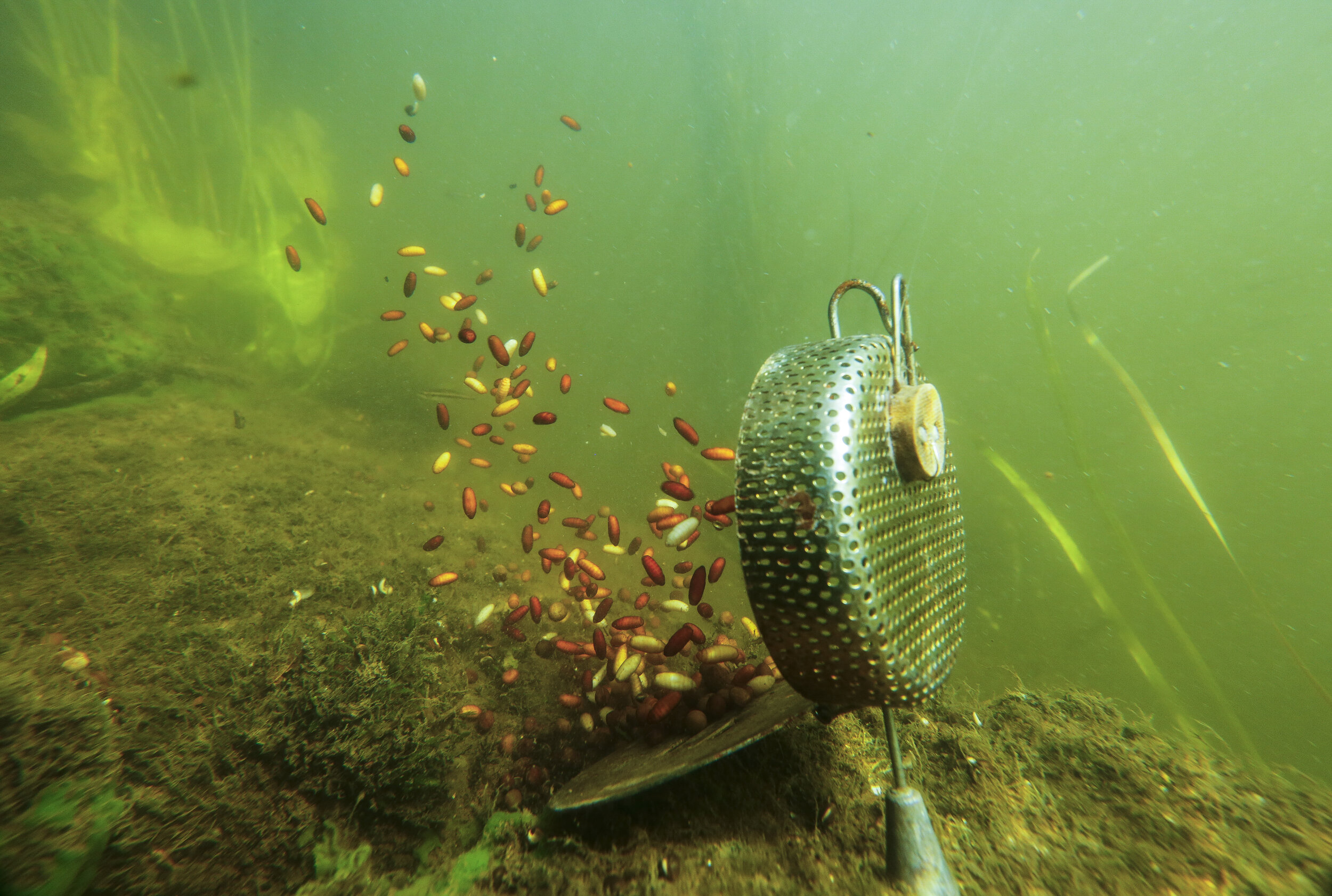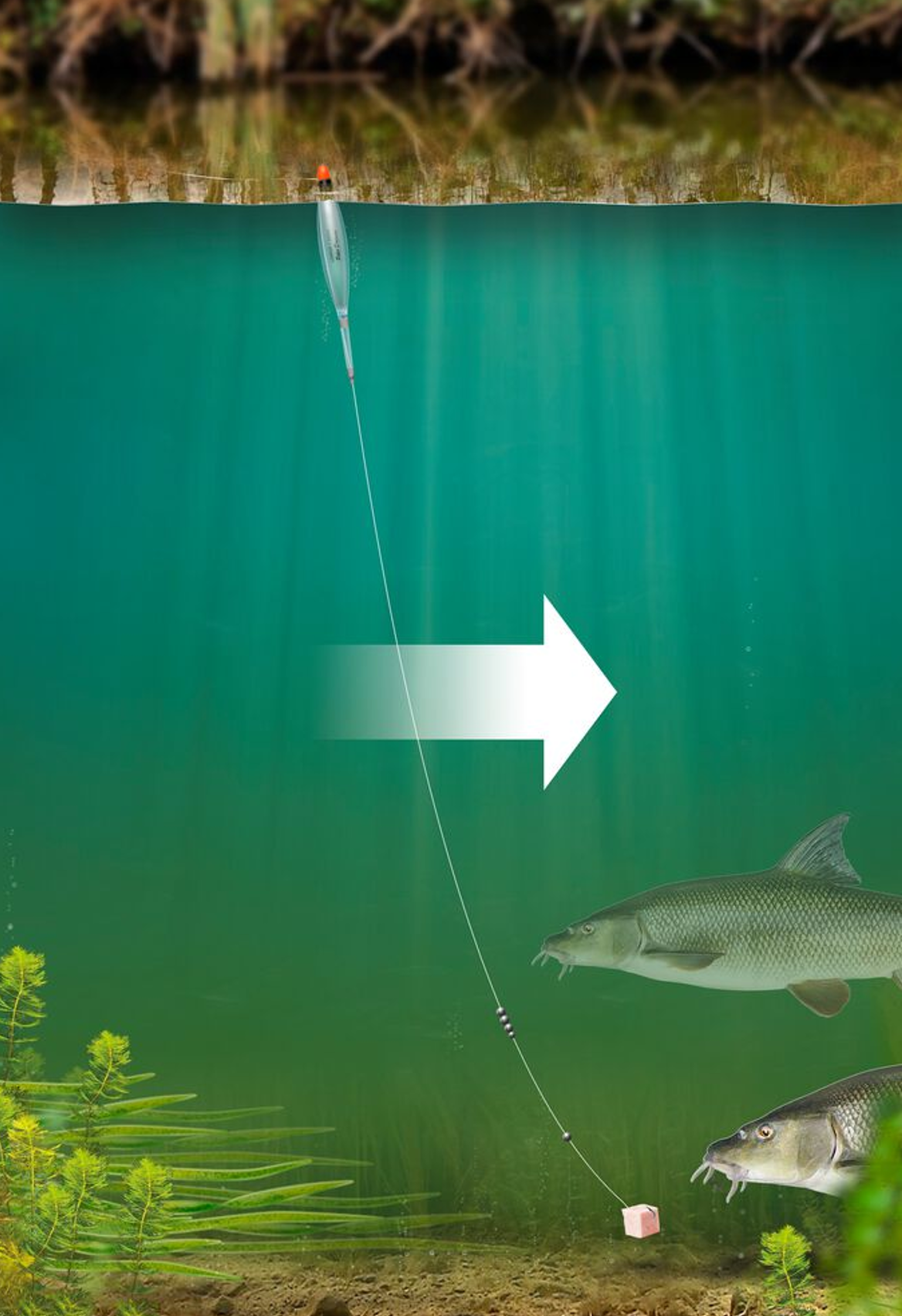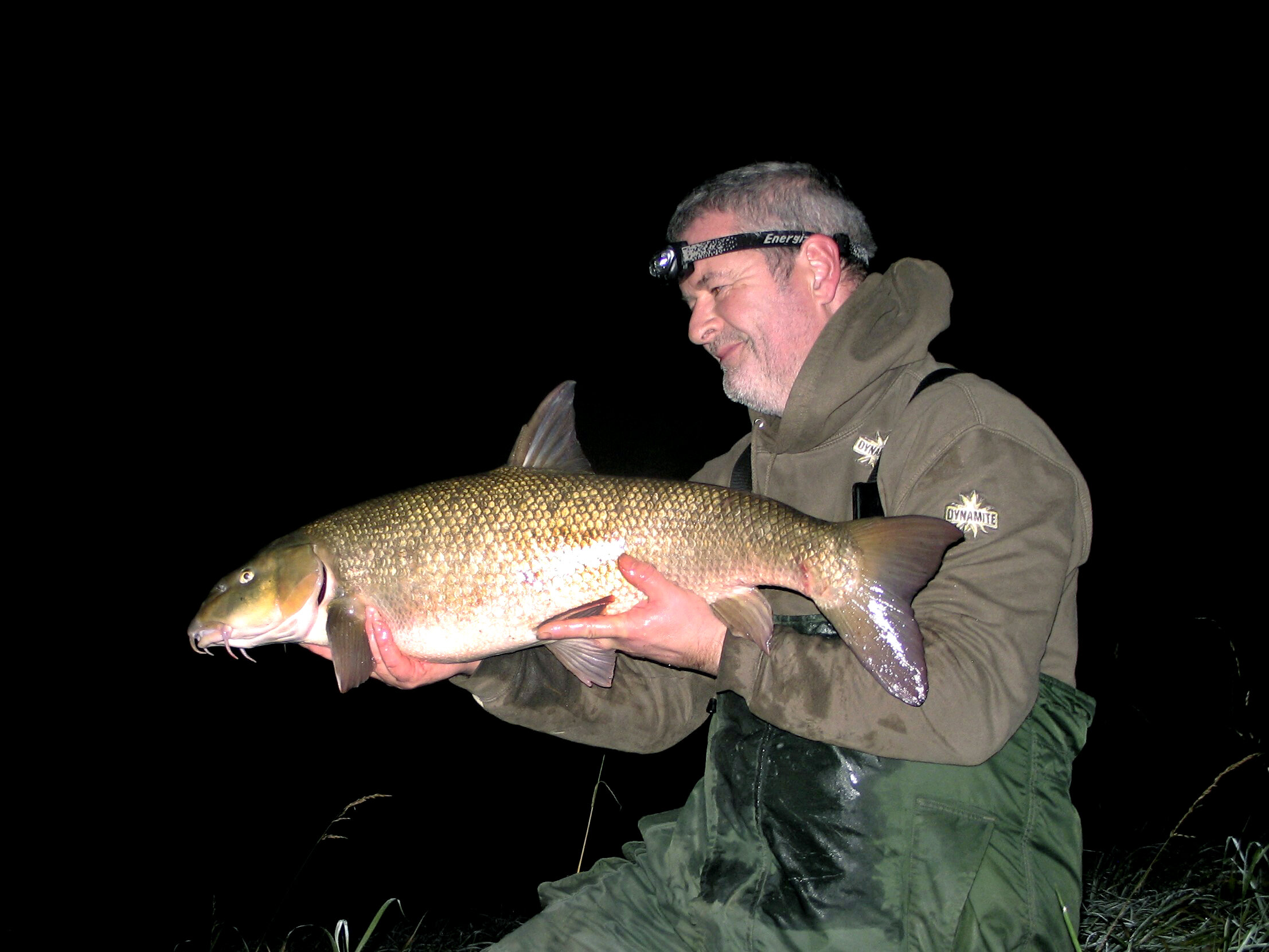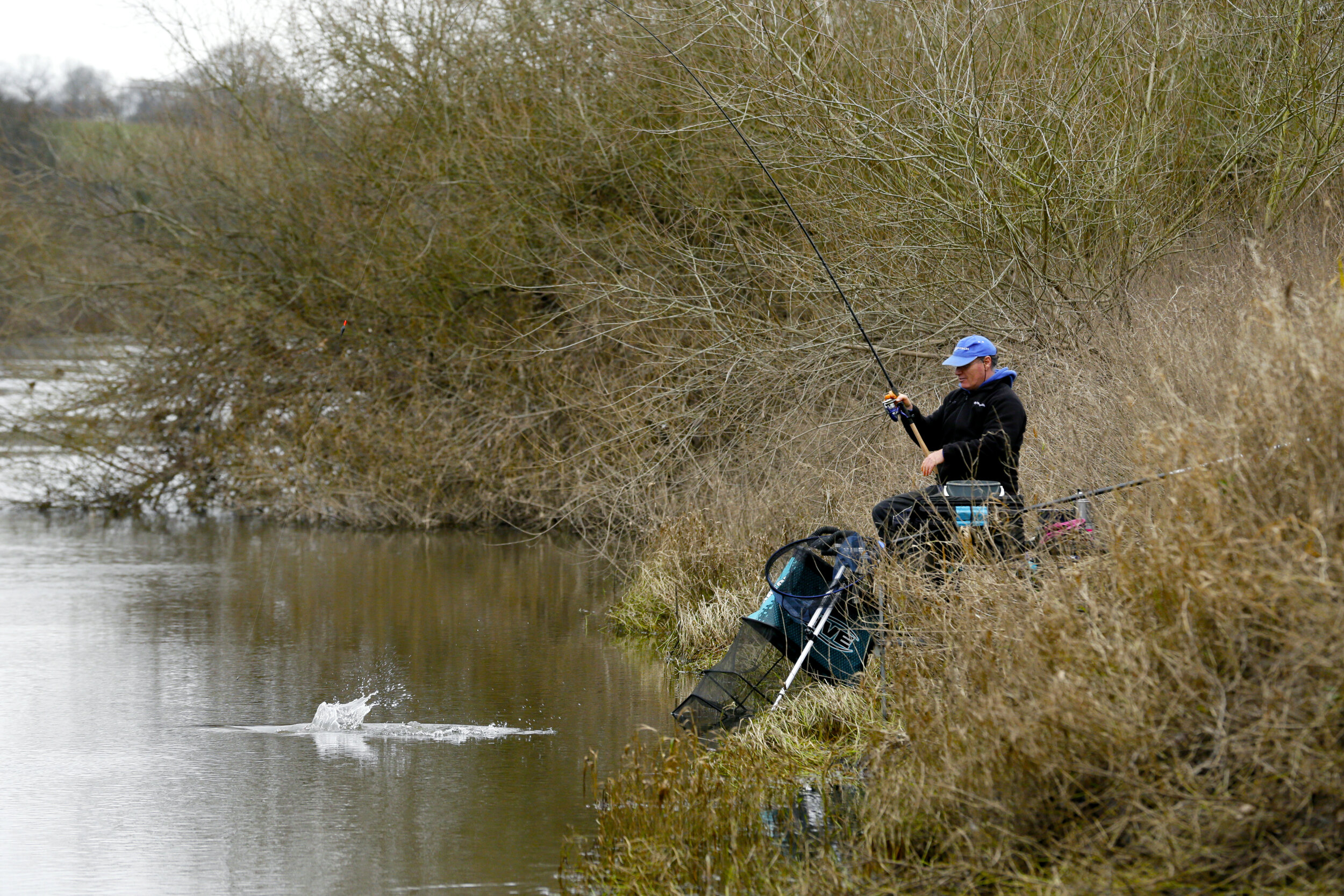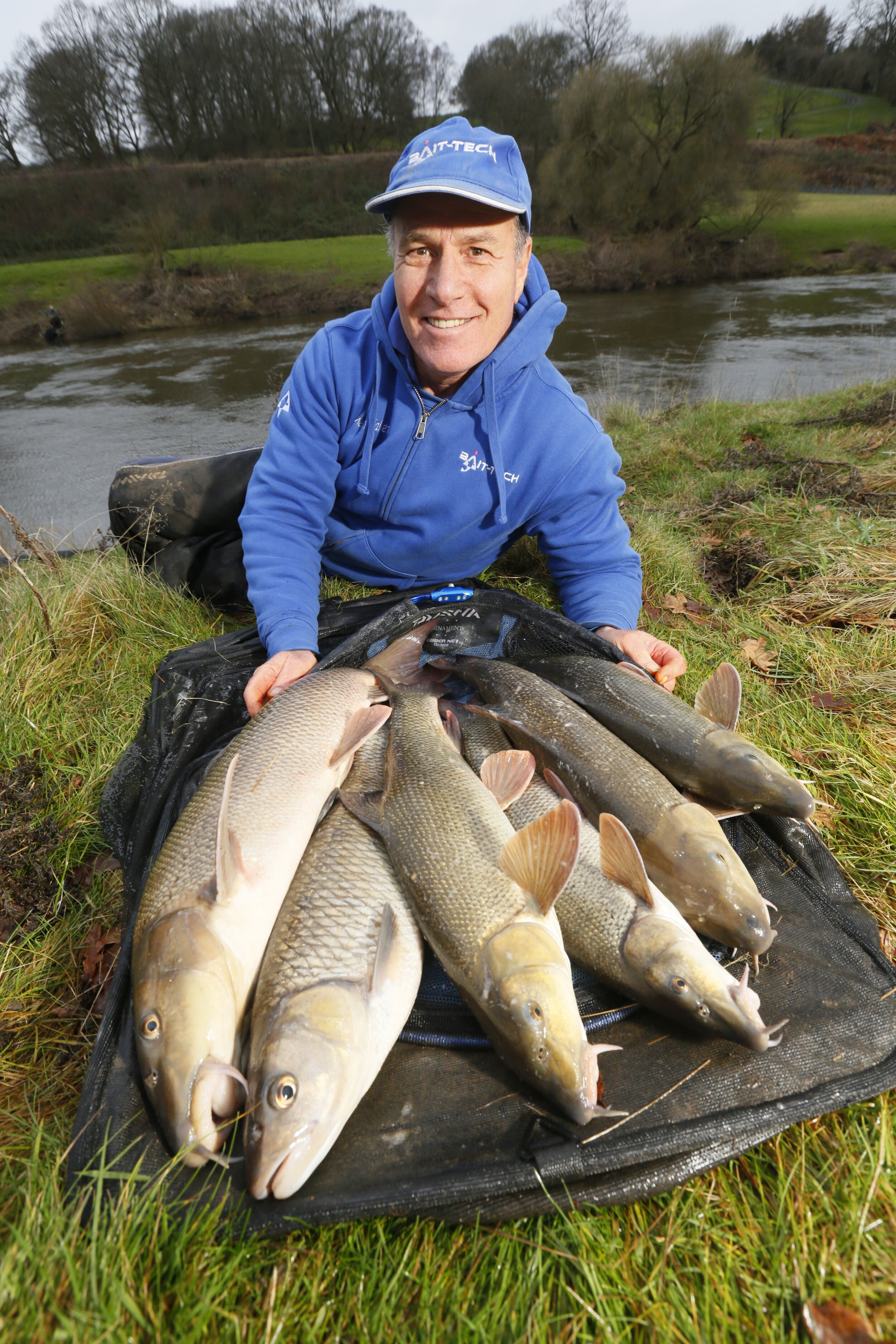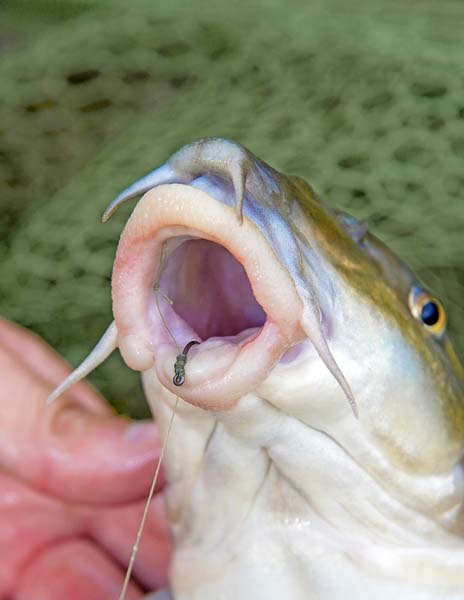River Fishing Tips | How to find barbel on a flooded river - Dai Gribble
In prolonged floods, barbel seem to gradually move out of the main flow into slower flowing water. I suspect this coincides with them having fed well and preferring to rest up in areas where they need to expend less energy.
Barbel will move away from fast flows in prolonged floods
This helps you locate the barbel as once the river has been in flood for a couple of days, they are more likely to be found in the classic flood swims where the flow is less than in the main river.
I’d look for the following:
Bends with slack water on the inside and a crease where the main flow passes by.
Cattle drinks where there is slow-flowing or slack water out of the main current.
Slacker water behind overhanging obstructions such trees.
Deep holes where the barbel can lie in slower flows beneath the main pace of floodwater.
Slacks downstream of large bridge supports.
Search out slacker areas of water for barbel in times of flood
River Fishing Tips | The best way to attach a PVA bag when barbel fishing - Jamie Cartwright
The best way I’ve found is to thread the PVA bags directly on to the hooklink using a long baiting needle.
I use a quickchange swivel and tie a loop in the end of my hooklink, which allows me to quickly take off the hooklink, thread on a bag of pellets and boilies and slide it down so it rests against the hook, then reconnect the loop to the swivel.
I use a lead clip arrangement when using mesh bags. A running lead can slide back up the line and you get too much separation between the lead and the bag, making casting difficult.
This is a vast improvement on just nicking a bag on to the hook, as more often than not the first part of the PVA to melt is the bit attached to the hook, and the bag can just roll away!
Threading a PVA bag down the hooklink is a reliable way to present loosefeed when barbel fishing
River Fishing Tips | How to bait for barbel - Dai Gribble
I prefer a bait dropper over making lots of casts with a feeder because it’s accurate and often much quicker too.
A bait dropper is a quick and accurate way to feed a barbel swim
I bait up with different-sized pellets and a few crushed boilies. The pellets keep the fish in the swim for long spells while the crushed boilies give them a taste of my hookbait.
Use a real mix of pellets to keep the fish in the swim for longer
Crushing the boilies releases lots of flavour. I’ll introduce around a pint of mixed barbel pellets and 30 crushed boilies, the exact amount depending on several factors…
The size of the river - The bigger the river I’m fishing, the more bait I will use.
Large well stocked rivers like the Wye, Trent and Severn require heavier feeding
Stock of barbel and other species - if I know there are a lot of barbel, chub, or even silverfish such as roach I will up the amount of feed I put in at the start.
If there are lots of fish they will need more feed
Temperature - As temperatures drop towards autumn, I will scale back on the amount of bait being fed.
Scale back the feed as temperatures drop
How long I am fishing for - The longer my session, the more feed I will introduce.
If you are fishing a long session, try a bait and wait approach
River Fishing Tips | 5 Tips For Barbel
Go for the gravels
Although a swim on somewhere like the River Severn might seem to have a similar depth and pace all the way across, there are definite areas that barbel prefer. The most productive of these will be shallow water, which in turn will be much faster and better oxygenated in summer when rivers are often low and sluggish. Combine this with a gravel bottom and you’re in business.
Gravels are a hotspot for barbel
Use enough lead
As with any type of fishing, your rig needs to act naturally in order to get a barbel to take the bait. That means keeping everything nailed to the deck. A feeder that’s carrying too little weight to hold bottom will roll down the swim, with no chance of a fish picking up the bait. Before the session, cast with a range of different weights of feeder until you find the one that holds bottom just where you want it. Be aware that the flow could increase when you start fishing, so have some even heavier feeders to hand just in case.
You need enough lead on the feeder to hold bottom
Don’t go undergunned
Barbel fishing isn’t like going after roach or dace. You have to make sure that you are able to take control of every battle and that means using suitably robust tackle. A long hooklength is important because the fish seem to spook and feed less confidently close to a feeder. Start with a 5ft tail of around 0.20mm hooklength material, matched to strong size 12 or 14 hook.
Don’t go too light for barbel
Old school baits can be the best
Pellets are catching ever more barbel on rivers, but at times they can be a bit too much of a slow burner. For a more high-impact feed, it’s hard to see past hemp and casters. These small particles, introduced via a blockend feeder, will keep fish grubbing around for ages and pull other valuable fish, such as chub and perch, into the area too, letting you catch these while waiting for a barbel to pull the rod in!
Hemp and casters are deadly barbel baits in clear water
Put a bow in the line
If you keep a very tight line between the rod tip and feeder when barbel fishing, then you’re asking for trouble! Bites can be ferocious and before you’ve even picked the rod up you could have been broken, even when using heavy gear, due to the lack of forgiveness in the set-up.
The solution is to have a bow in the line, which means that the line is slacker and creates a cushion that reduces the chance of being smashed. Bites when fishing like this will normally be a sharp knock on the tip and then a drop back as a fish moves the feeder and the line slackens off.
Fish with a bow in your line
River Fishing Tips | Cage or solid feeder for barbel? - Dai Gribble
As well as carrying feeders of different sizes and weights, it pays to have different types in your tackle box so you can vary the rate at which your feed is released into your swim.
Cage and solid feeders both have uses in barbel fishing
A cage feeder will empty much quicker than a traditional, solid-style feeder with just a few holes. So, If bites are coming soon after casting, opt for a cage feeder so that the bait is deposited rapidly int the swim, otherwise the feeder will still be full while you are playing a fish and will end up emptying its contents across the river.
Cage feeder barbel fishing rig
If bites are slow in coming, however, it pays to use a solid, slower-release feeder to ensure bait is trickling past your hookbait and down to the fish for much longer.
A cracking River Severn barbel
River Fishing Tips | How to catch more barbel in the day - Phil Smith
There are a few things you can do to boost your daytime catch rate, starting with targeting waters that don’t allow night fishing.
A fantastic conditioned double caught in daylight hours
It may seem strange, but on venues where night fishing is allowed, it appears to encourage the fish to feed better in darkness, and less during the day.
I’d also recommend smaller baits, the obvious ones being maggots or casters. Bait droppering with hemp and caster, say, 10 droppers of each, then leaving it without casting in for an hour will get results.
Casters are a deadly bait in the daytime
For hookbaits, I favour hair-rigged casters or maggots mounted directly on to a size 12 hook. Some of my best specimens have fallen to these tactics.
Fake casters are a good hook bait to avoid small fish
River Fishing Tips | The best float rig for barbel - Dai Gribble
SOME people favour using big wagglers, especially if it’s windy, but most of the time when trotting for barbel I use two types of float – Chubbers and Avons.
I use both Chubbers and Avons
Avon floats, with their large shoulders and heavy wire stems, are best suited to deeper water and slower flows, while the more streamlined Chubbers, or Loafers as they’re sometimes called, work best when used in shallower, faster water.
It’s important to use a big enough float to boss the river, rather than letting it boss you, so I rarely use a float with less than 3AAA loading and, depending on flow and depth, I will use them as big as 5SSG.
I start with the bulk of the shot set 50cm-60cm from the hook, with a single dropper shot, generally a BB, between the bulk shot and the hook.
A standard barbel float rig
Although barbel will sometimes take a bait presented off the bottom, I want my bait running along the bed of the river as that is where it is most likely to be taken, so my shotting is designed to get the bait down to the feed area as quickly as possible.
They are great fun on the float!
River Fishing Tips - How to fish for Wye barbel - Kevin Clark
The River Wye is one of the most scenic, prolific and best barbel rivers in the UK.
If it is your first time on this beautiful river, however, it can be a bit daunting due to its large and powerful nature. So how should you approach the fishing?
At the start of the river season you should be fine with a quality 8lb mono, a 1.5lb test curve rod and a reel with a good clutch.
I’d suggest a 2oz gripper lead and an open-end feeder to start with. Try casting upstream, which helps to hold bottom with less weight – handy if you’ve forgotten your feeder add-on weights or you’re slightly undergunned with your leads. Let a bow of line out between rod-tip and feeder before sitting the rod on the rest.
A gripper lead will help you hold bottom
A high oil pellet approach should serve you well on most Wye stretches, or small cubes of meat on 8lb fluorocarbon hooklengths, provided your stretch is not too snag-ridden.
Kevin Clark with the Wye record barbel of 14lb 12oz
River Fishing Tips | How to avoid small fish to catch barbel on the float - Hadrian Whittle
If small fish are a nuisance on the float when barbel fishing, I have two bigger bait options. My first choice is an 8mm piece of meat hooked on a size 12 Gamakatsu 2210 Blue or a Kamasan Animal hook. If this fails, then I’ll try an 8mm or 10mm pellet.
Barbel can be great fun on the float in the summer months
I like to carry some halibut, Red Krill and natural carp pellets to give me a colour variation to try throughout the day. These are put in a band on a short hair rig. As for feed, lots of hemp and caster is key. I will feed a few 4mm and 6mm halibut pellets and a few cubes of meat in this as well.
Feed a mix of 4mm and 6mm pellets with the some cubed meat thrown in.
If small fish are a real nuisance, then try not adding any casters to your feed.
A beautiful float caught Wye barbel
River Fishing Tips - Quivertip or bite alarm for barbel? - Tony Gibson
Barbel bites are always positive so I don’t use rods with built-in quivertips – you’ll know when there’s a fish on!
I favour a through-actioned rod with a test curve of 1.5lb to 2.25lb, fixing an isotope to the end if I’m fishing in the dark.
Generally, I’ll watch the rod-tip when roving around on a small river or when I’m not planning on spending a lot of time in each swim. Alarms come into play when you’re in for the long haul on rivers like the Trent, fishing for 12 or 24 hours in the same swim and waiting for a bite.
I’ll always prefer watching the rod-tip – seeing it slam over and hearing the clutch scream is the best bit in my book!
Seeing the rod-tip slam over is the best bit about barbel fishing!
River Fishing Tips | Six tricks to catch the bigger river fish - Darren Cox
Hungry as the big specimens may be, the appetites of their smaller brethren will be just as keen, and a day can be soured by a never-ending stream of tiddlers and nothing substantial to put a bend in the rod.
On a river, it’s not that easy to single out the chub and bream when there are hordes of tiny bleak and dace to wade through. You will have to put up with catching some of these smaller fish, because that’s just the way it is, but there are plenty of tricks you can try to sort out the proper big boys!
“It’s not that easy to single out the chub and bream when there are hordes of tiny bleak”
Find the fast water
Find swims with faster water that will be well-oxygenated. Most species will have finished spawning and will move into gravel runs in fast water. You’ll still find little fish there, but that’s where the chub will be.
Fast well-oxygenated water is best for big fish early in the season
Use big baits
Maggots will be a waste of time. Casters are a favourite and tend to sort out the chub and big roach. If you’re still getting pestered by bleak and dace, though, use tares or a kernel of corn.
Bigger baits for bigger fish - don’t waste time with maggots!
Tackle up properly!
Big hooks and stronger lines will make sure you land chub and even barbel and will also put the smaller fish off. Try a size 16 hook to a 0.12mm or 0.14mm hooklength.
Use bigger hooks and stronger line
Up the feed
Feed hemp and caster in a ratio of 50/50. Begin by feeding sensibly to work out how many bigger fish are there. If small fish are a problem, double the feed.
Keep the feed going in and double the ratio if small fish are becoming a problem.
Go shallow
Fish will be very active in early season and may be feeding off bottom. This is especially true of chub. A small stumpy waggler fished at half-depth is a super way to catch chub darting about up in the water.
Try a small waggler fished at half-depth for chub
Fishmeal groundbait
Bream are the main target on slower rivers, but even on the feeder, little fish can dominate. Use a fishmeal groundbait, which dace and roach aren’t so keen on. Add inert particles like hemp and casters.
Fishmeal groundbait is a great attractor for big bream
River Fishing Tips | Is it worth prebaiting for barbel? - Martin Bowler
The answer to that question is a resounding yes, provided the river isn’t in heavy flood.
I often prebait with groundbait balls in summer, before leaving the swim for a few hours – or even overnight – for the fish to find the free grub and gain confidence.
Leave the swim for a few hours or even overnight for barbel to gain confidence
Depending on the depth, flow and pace, I’ll typically throw the balls five to 10 yards upstream of the spot I intend to fish.
You can use whatever bait you want, and my typical mix consists of Sticky Krill Active Mix, pellet crumb, trout pellets and Ellipse pellets. Six orange-sized balls are normally enough to work the oracle, and I’ve had some great results on rivers such as the Wye and Trent using this tactic.
Martin Bowler is no stranger to catching big barbel
For more from Martin, pick up Angling Times magazine every Tuesday!
River Fishing Tips | PVA or feeder for barbel? - Alfie Naylor
Both the feeder and PVA bag have their place in barbel fishing and are brilliant tactics at delivering loose-feed close to your hookbait.
Personally, I think that a PVA bag and lead arrangement creates much less disturbance than a feeder. The feeder does work for the bigger barbel, though, if you want to slowly build a swim by constantly casting and introducing bait.
The feeder is a great tool to build a swim with feed
When fishing for barbel on rivers like the Trent, I like to put a fairly big bed of bait out at the start, then have one cast with a bag on and leave the bait out until I get a take. After each fish, I’ll top up with two bait droppers of feed.
I prefer to use a PVA bag for a ‘bait and wait’ approach
I feel the disturbance from me landing a fish pushes them away from the baited area, and now is the time to feed the swim again.
Both methods will catch big barbel if used correctly
River Fishing Tips | Tame the Severn on float and feeder with Kelvin Tallett
We are all guilty of falling into lazy habits with our fishing, simply setting up one rod and waiting for a bite – but when targeting winter chub and barbel on the river this isn’t always the right way to go.
It’s very rare that you can lob out a feeder and catch steadily all day, as you can in summer, but by alternating between the feeder and the float you can stay one step ahead of the fish, and catch a lot more in the process.
I discovered this during a recent session on the River Severn at Arley, Worcestershire, where regularly changing my tactics resulted in a cracking bag.
Meaty Maggots
The only bait I took with me was a gallon of bronze maggots, with a few reds mixed in. I know that these are great for winter chub and barbel – the key to success would be to discover the right tactic for the day in question.
I’m a big fan of boosting my maggot hookbaits, and one of my favourite additives is Bait-Tech’s Sizzling Spicy Sausage glug. After riddling the maggots off, I’ll add a decent spoonful of flavouring to every few pints of grubs, before tying them up and leaving them in a bag overnight.
This gives the flavouring time to soak into the bait, but the biggest advantage, I find, of doing this is that it makes the maggots wriggle more in the cold, which in turn makes them more enticing to the fish. Although not everyone is convinced by glugs and additives, in my experience they really do work, so I would recommend giving them a go.
Starting on the Stick
I arrived at the river to find it running a foot above normal level with a decent colour. Combined with mild and overcast weather, I was hopeful of a few bites.
I sat in a typical Severn swim – long and open, with 500 yards of river visible downstream.
A hundred yards down the peg the riverbed shallowed slightly, and it’s an area where I knew the fish love to sit in summer. In the colder months, though, they move into the deeper water, which is where I would be focusing my attack today.
Setting up a stick float, a Bolo float and a maggot feeder, I started on the stick just to get a feel for things, feeding two half-pouches of maggots every run down.
You may be wondering why I didn’t just feed one big pouch, but feeding smaller amounts more regularly keeps a steady stream of bait flowing through the peg. This really gets the fish competing.
After an hour’s fishing I hadn’t received a bite, which was slightly unusual, but I wasn’t too worried – I simply reached for the feeder rod instead.
Feeder Success
Five quick casts put a bit of bait down in a specific area of the swim, and 20 minutes later the tip bounced round and I was into a hard-fighting fish.
A good barbel was netted shortly after that, and over the next half-hour I put two more barbel in the net, the bigger of which was a clonking fish close to 10lb.
Following this burst of activity, the swim went through a 30-minute lull and I suspected that the fish had dropped downstream.
I responded to this change by picking up my rod with a Bolo float attached. With this set-up I was able to follow the shoal as it moved gradually further down the peg.
Bolo Bagging
After feeding a few more pouches of bait I swung the Bolo out, and shortly after that the float tip plunged beneath the surface.
Another barbel was the culprit, and over the final hour it was followed by one more of its mates, as well as a bonus chub.
Eventually the fish backed off further and further downstream and it became increasingly difficult to keep in touch, so we decided to call it a day.
Had I not set up the Bolo rig the action would have come to a much swifter conclusion, and I would have gone home having caught just a few early fish on the feeder.
Pulling out the keepnet, I reckon I had around 30lb, all taken in just over three hours’ fishing. I’m sure that without the choice of tactics, my final tally would have been around half that weight, whereas by switching between the float and feeder I was able to stay in touch with the shoal.
There’s no doubt that you will still catch by just setting up a single rod, but next time you go out on the river make the effort to give yourself a few options – it could just result in a session you won’t forget in a hurry!
Kelvin’s Tackle
Rods: 13ft Daiwa RS Power Waggler, 12ft/13ft Daiwa RS Power Feeder
Reels: Daiwa TDR 3012
Line: DH Angling Pro Float 6lb, DH Angling Pro Feeder 8lb
Hooks: Drennan Wide Gape size 12
Floats: DH number 2 Heavy Base stick 8x4, DH number 2 Bolo 4g
Feeder: 60g Nisa Block End
River Fishing Tips | How to catch more fish from tricky rivers
Low, clear and full of weed – summer rivers can be tricky places at the best of times.
The fish are spooky, and will often sit out of sight. However, do it right and the results can be breathtaking, as Garbolino UK boss Darren Cox proved recently on the Warwickshire Avon, where he landed two barbel for 22lb in a match.
We caught up with Darren for his tips on how best to approach these challenging waterways, right now.
Swim selection
“When the temperatures are high the fish will be looking for oxygenated water, so weirs, rapids and shallow areas are the places to target.
“I always like to fish over gravel if I can, as fish seem to prefer lying over it, and anything that gives the fish cover is great to target.
“Features such as trees, weed or reeds are always good to look out for. On the day of the match I drew a peg that was very weedy and snaggy, which was why the fish were there.
“The first barbel I had, a fish of 11lb 14oz, snagged me up four times during the fight, but by using the correct tackle I managed to land it.”
Tackle Choice
“Most barbel anglers opt for quite a pokey rod up to a test curve of around 2.25lb and 15lb line. However, I much prefer something softer. During the match I used 6lb Maxima mainline and an 0.23mm hooklength.
“While 6lb Maxima will break at much more than 6lb, the soft rod I use in conjunction with this tackle is one of the most important parts of my set-up.
“I actually think this is better for playing barbel on, as it absorbs the lunges of the fish much better than something stiffer does.
“It may seem under-gunned, but the fact that I landed two double-figure barbel and didn’t lose a fish in such a snaggy swim shows that the gear is up to the job.”
Tactics
“On the day of the match I set up both a float and a tip rod, but the river was pushing through too quickly and was a bit too weedy to run a float through nicely.
“I caught the larger barbel on a feeder, and after getting a few line bites I knew there was something substantial in the swim. It’s always worth setting the float up, though, as it’s a great way to present your bait when the pace is right.
“Even if you don’t catch on the float it’s still a great way to search the swim, as you can find out where the fish are lying.
“A dome-topped balsa float is my preferred option when fishing for big fish with large baits, and I’ll often lay two feet of line on the deck so that I can really drag my hookbait through the swim.
“If you have a large snag in your swim it’s always best to try and draw the fish away from it with feed – however, sometimes this just isn’t possible.
“On such occasions, you have to be prepared to go right into the lion’s den!”
Choice of Bait
One of the biggest problems on summer rivers can be the large shoals of tiny fish such as bleak.
These can destroy your hookbaits, so you want to be using something that excludes these species.
Hemp and casters are a great all-round option, but if you’re going specifically for roach and chub then tares are a favourite of mine. During the match I fed four pints of hemp and casters, as well as a cubed tin of Mainline Match Spicy Brown meat.
The benefit of feeding the meat is that I know that this bait will reach the bottom through all the small fish, which will leave something for the bigger fish to eat when they move into the swim.
River fishing tips| How to catch barbel while fishing a river.
The river season is now in full swing so to help you have your best-ever river fishing season we’ve brought you some of the best tips from top river and specimen angler Dai Gribble.
Here some of the best river fishing tips to try right now.
Try using small hooks
Barbel are outstanding fighters, but don’t let this fool you into thinking you must use big hooks for them.
Smaller, strong hooks can be much more beneficial, especially when fishing in daylight when they can be finicky feeders.
Scaling down your hook size can make a big difference in not spooking the fish. They also allow you to use smaller particles.
There are many small hooks such as the Korum Specimen that are strong enough in size 14 and 12 to cope with big barbel. I use them for small baits such as 8mm pellets, mini boilies and single grains of corn.
Keep your rods up
We’ve had a bit of unseasonal weather at the start of this season, with many rivers carrying extra water from the high rainfall.
This makes it even more important to fish with your rods up in the air, because fishing in this way helps you to minimise the drag on the line from the current.
This lets you to hold bottom with lighter leads and feeders, giving you a more sensitive set-up with better bite indication.
Smaller leads and feeders also cause less disturbance, reducing the chances of spooking fish when you cast out.
Carry a range of feeders
Carry a wide range of feeders of varying sizes and weights so that you can select the right one for the job.
Different weight feeders will be required depending on the depth and flow of the swim you are fishing, and different sizes allow you to vary the amount of bait that you introduce.
Generally the deeper, faster flowing and further across I am casting, the heavier the feeder needs to be to hold bottom. The aim is to get the feeder to quickly hold in one place after it has settled after casting.
Feeding rates
As well as carrying feeders of different sizes and weights, it pays to carry different types.
This will allow you to vary the rate at which your feed comes out of the feeder. A mesh feeder will empty much quicker than a traditional-style feeder with just a few holes.
If bites are coming soon after casting, opt for a mesh feeder so that the bait empties quickly, otherwise it will still be full and empty across the river whilst you are playing a fish.
If bites are slow it pays to use a slower release feeder to ensure bait is trickling past your hookbait for much longer.
Running rigs rule
A free-running kit is ideal for barbel. I was lucky enough to test the new Korum Bolt and Run kits and will be using them this season for all my barbel fishing, they’re that good.
With this rig the ring holding the feeder or lead is semi-fixed which provides a great bolt effect when a barbel takes the hookbait. As it is only lightly fixed it comes free instantly a fish is hooked.
Combined with an anti-tangle sleeve this rig is easy to cast without tangling as the feeder or lead stays in place and there is no possibility of it sliding up the mainline when the feeder hits the water.
Look after the fish
Anglers need to prioritise fish care over everything else, particularly in the summer when higher water temperatures mean the water holds less oxygen.
There are a number of measures you can take to minimise the impact on barbel.
Firstly, always rest the fish in the landing net for at least a couple of minutes to allow it to recover before lifting it out of the water. If possible, unhook the fish in shallow water and release it immediately.
Consider whether you really need a photograph and whether it is necessary to weigh a fish.
If it looks close to a target weight then weigh it, but if you are fishing for big specimens do you really need to know exactly what a smaller fish weighs?
Barbel fishing tips | Top barbel tips to get you started
Barbel fishing has really grown in popularity in recent seasons so if you’re just starting out on your barbel fishing adventure then you’ll want to look at these great tips from Drennan Cup winner Dai Gribble who has landed many specimen sized barbel over the years. He’s got you covered and with the help of these great tips you’ll be able to catch a barbel next time you are out on the bank.
1) getting the right FEEDER MIX for barbel
There’s no doubt that pellets are a very effective bait for barbel, and my feeder mix reflects this.
You’re looking to create a potent-smelling mix which can draw fish into your swim, and one that will keep them there for the maximum amount of time.
I use Sonubaits Barbel Pellets mixed with Hemp and Hali Crush groundbait – both of which have been purposely designed for river barbel fishing – and I will mix them in a ratio of around one part pellets to three parts Hemp and Hali Crush.
Small particles are best for keeping fish in your swim for longer and I like to use a range of sizes of pellet from 2mm up to 6mm so the fish don’t get preoccupied with one size of bait.
The pellets will slowly get washed downstream by the current, creating a bed of bait, while the finer particles of the groundbait will be washed further downstream, giving off a trail of attraction which will draw fish up towards the bed of pellets.
2) The perfect barbel Hookbait
For big-river barbel I use pre-drilled 6mm or 8mm Sonubaits Pellet-O’s and attach them with a Korum pellet stop which pulls back slightly into the pellet.
This needs to be taken into account to ensure the hair is the right length – always tie the hair a little shorter than you think you’ll need, because the pellet stop will extend it.
I find the easiest way to get it right is attach a pellet to the hair before tying the knotless knot, as this will ensure the hair is exactly the correct length.
I like to take a selection of hookbait flavours and colours with me to the bank, as this allows me to experiment during the course of a session.
In terms of flavours, I’ve caught particularly well on crab, halibut and krill-flavoured pellets.
A great trick to try is to glug your pellet hookbaits in Pellet Oil. This toughens them up, and that way they’ll last longer on the hair.
3) The best Tackle for barbel
I like a 12ft rod, as it helps keep the line out of the flow ands hold the feeder in position.
A freespool reel, set correctly, eliminates the risk of a barbel pulling a rod into the water.
Most times I prefer a single rod but if bites are hard to come by I’ll fish a second on the same line, a few yards further downstream. I fish it with a straight lead rather than a feeder, as I don’t want spread bait around the swim, preferring to stick with one baited area.
Plenty of bait will be carried past this downstream rod and the hope is that it will pick up fish reluctant to move over the main baited area.
Want more barbel fishing tips?
Hungry for more tips about barbel? Then make sure you check out our barbel species page, which has tips from loads of professional anglers to help you catch more next time you’re on the bank. Click here to see more tips.
Fishing Near Me | Where to catch barbel?
Don’t know where to go fishing for barbel? Then don’t panic as we’ve got you covered with our Fishing Near Me page, we’ve got loads of venue listicles on every species so you’re guaranteed to find somewhere to fish. Click here to see more
The best feeders for barbel fishing
On big rivers such as the Severn, Wye and Trent every swim is different, so a selection of feeders is important. A number of factors decide me on which feeder to use in any given swim. First, how much bait do I want to introduce?
I generally start with a large feeder for the first hour and cast every 15 minutes or so to lay a bed of bait down. If bites come I’ll stick with a large feeder – if not I will switch to a smaller one and recast every half-hour.
In fast-flowing swims I like to use a traditional style of feeder with holes, but in slower swims a mesh-type feeder can be a better option, as it releases its contents more easily.
The weight of the feeder is determined by the depth, flow, and distance across the river I am casting.
Generally the deeper, the faster flowing the river and the further across I am casting, the heavier the feeder needs to be to hold bottom. I aim to get the feeder to quickly hold in one place after it has settled after casting.
Open-End feeder
A traditional open-end feeder offers a slower release, as the water cannot get to the bait so quickly. This can be really useful in deeper water or very fast flows.
Mesh feeders
Mesh feeders will release bait quicker and activate a swim sooner than other kinds of feeder. The cage-like structure allows water to start breaking down your mix quickly.
Combi feeder
A Combi, or blockend, feeder really slows down the release of bait because the ends are closed. It’s preferred when maggot fishing, but is also useful with a standard pellet mix.
River feeder
This special Korum river feeder has been designed so you can use less weight in faster flows. The low profile stays pinned to the riverbed and is unobtrusive to big barbel.
Barbel fishing tips | Where to find the
Barbel fishing can be difficult at times but knowing where to find them will certainly help in your expedition to land a monster. We’ve put together some top barbel tips to help you find them on your local river.
It sounds obvious, but barbel are not spread evenly throughout a river, so before casting out it pays to take a little time to not only pick the right stretches, but also the right parts of the river to help narrow the odds in your favour.
Here are some top barbel hotspots to check out next time you are out on the bank.
A) Speedy shallows
Barbel have evolved to live in fast-flowing rivers and are perfectly adapted to fast currents, especially in low, clear water conditions.
Look for streamy, shallow water in the summer and don’t be put off by a depth as little as 50cm. If there’s cover provided by either weed or overhanging trees, so much the better, as that’s where you’ll find the fish.
B) Look for faster water
At this time of year it’s all about fishing the faster water. Barbel are designed to swim in fast currents with very little effort as long as it’s well oxygenated, so areas near weirs are worth targeting.
Some anglers make the mistake of fishing deep holes and slack areas in summer. These are easy to locate and fish, but they’re often bereft of barbel.
These same areas can be good on high, flowing rivers in the colder months, so make a note of them for later in the year.
C) Target weeds and gravel patches
Fishing between weedbeds is always a good idea, as the fish can sit in there without expending much effort and still get all the oxygen they need, picking off opportunist food items as they flow past them.
Barbel also like looking for food on gravelly areas and you can usually find them feeding on the cleaner gravel patches. In fact, some of these patches are clear because the fish regularly feed over them!
D) Find the creases
Swims with different depths are also very likely to hold barbel, as are “creases” in the river, where the faster flowing water passes water moving at a slower pace.
A crease is where the river looks creased, like a piece of paper – you should cast just into the faster water, so any fish in the slower area can drift over your bait.
Don’t follow the crowds
A tale from last season illustrates how not following the crowd can pay dividends. I arrived at the River Wye and spoke to four different anglers who were all struggling to catch and had convinced themselves the barbel were simply not feeding.
These men had one thing in common – each of them was set up where the grass had been worn away, a sure sign these swims had been heavily pressured over a long period.
I decided to walk a bit further from the car park than they were fishing and beat down nettles and Himalyan balsam to get to the side of the river in a swim that clearly had not been fished for months.
I could see a nice channel between weed beds and cast a feeder in. Less than five minutes later I was in business.
In three short visits to the swim that evening and the following day I landed 20 barbel – not bad considering ‘they’re not feeding’!
Be prepared to move
Another good habit if you don’t catch within an hour or two is to get up and go somewhere else – don’t stick in one place simply because you’ve put some bait in.
It’s far better to try a different swim – you can always return to try again later in the original spot.
With barbel fishing, effort usually equals reward, and it is worth the effort to move in the hope of finding fish. Generally, barbel are not that difficult to catch – as long as you have them in your swim, of course!
Moving swims is made much easier if you make a point of being organised with your tackle. I try not to take too many items of tackle, preferring to use a large Korum ruckbag that I can load according to the length of my session.
To this, I clip my chair and unhooking mat, leaving my hands free for a pair of rods or quiver, and a bucket of bait. On a shorter session I can even fit my bait bucket inside the ruckbag.
WANT MORE BARBEL FISHING TIPS?
Hungry for more tips about barbel? Then make sure you check out our barbel species page, which has tips from loads of professional anglers to help you catch more next time you’re on the bank. Click here to see more tips.
FISHING NEAR ME | WHERE TO CATCH BARBEL?
Don’t know where to go fishing for barbel? Then don’t panic as we’ve got you covered with our Fishing Near Me page, we’ve got loads of venue listicles on every species so you’re guaranteed to find somewhere to fish. Click here to see more



